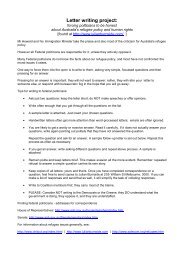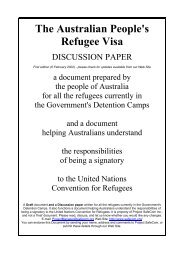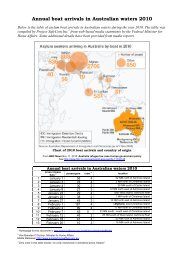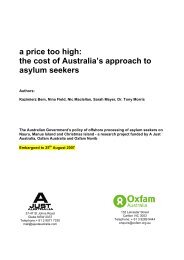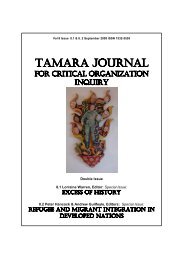TA B LE O F C O N TENTS
Australia's New Approach to Asylum Seekers - Refworld
Australia's New Approach to Asylum Seekers - Refworld
- No tags were found...
Create successful ePaper yourself
Turn your PDF publications into a flip-book with our unique Google optimized e-Paper software.
SEA CHANGE:<br />
AUSTRALIA'S NEW APPROACH TO ASYLUM SEEKERS<br />
I. INTRODUCTION<br />
In August and September 2001, the international<br />
community witnessed a dramatic example of<br />
Australia’s efforts to prevent unauthorized boat arrivals<br />
to its shores. The Australian government refused<br />
to allow the entry of more than 400 persons—mostly<br />
believed to be from Afghanistan—aboard a Norwegian<br />
freighter, the Tampa, that had rescued them at sea<br />
and attempted to bring them to Australia’s Christmas<br />
Island. Eventually, Australia struck a deal with<br />
Nauru—one of the world’s smallest republics—to<br />
house the asylum seekers while their claims were<br />
processed, in exchange for U.S. $10 million in aid.<br />
The Tampa incident commanded headlines and<br />
ushered in a significantly new approach to Australia’s<br />
treatment of unauthorized arrivals. Australia’s previous<br />
policy had been to transport people arriving without<br />
documentation to mainland detention facilities<br />
and allow them to apply for asylum.<br />
Despite the publicity this group received, it was<br />
hardly the first to arrive by boat at Australian territory.<br />
During Australia’s fiscal year 1999-2000 (which ended<br />
June 30, 2000), 4,175 unauthorized migrants arrived<br />
on the nation’s shores by boat—an increase of 354<br />
percent over the previous year. 1 In fiscal year 2000-<br />
2001, the number decreased only slightly, to 4,141. 2<br />
While the first few months of fiscal year 2001-2002<br />
showed continued steady arrivals, the pace of arrivals<br />
increased dramatically in August.<br />
The majority of recent arrivals have been from<br />
Afghanistan and Iraq, with smaller numbers from<br />
Iran, Pakistan, and elsewhere. Most have travelled<br />
through the aid of organized smugglers. As the<br />
number of such arrivals has increased, Australia has<br />
embarked on a multi-pronged approach to discourage<br />
and prevent such migration, either at its source, en<br />
route, or upon arrival. Australia initiated most components<br />
of this approach months or years before the<br />
Tampa’s much-publicized saga.<br />
One controversial component of the government’s<br />
plan is an “overseas information campaign.” Along<br />
with posters and other materials, the campaign has<br />
included video spots showing the shark-infested seas<br />
around Australia, the crocodiles closer to shore, and the<br />
snakes further inland—where, as it happens, some of<br />
the detention centers housing unauthorized migrants<br />
are located. The title, and the message, of the campaign:<br />
“Pay a people smuggler and you’ll pay the<br />
price.”<br />
Another component involves cooperation with<br />
other countries, including the “source countries” of<br />
asylum seekers (such as China); countries of “first<br />
asylum,” which asylum seekers enter when fleeing<br />
their homelands and where they sometimes reside for<br />
months or years (such as Pakistan and Iran); and the<br />
transit countries (such as Indonesia) through which<br />
asylum seekers pass on their way to Australia. The<br />
Australian government believes that its negotiations<br />
with the Chinese government are responsible at least in<br />
part for virtually stopping the arrival of Sino-Vietnamese<br />
“boat people” in Australia. Australia seeks similar<br />
results with respect to Afghans, Iraqis, and others from<br />
the Middle East/South Asia region, who now form the<br />
bulk of the new arrivals.<br />
Other components of Australia’s effort to deter<br />
unauthorized migration include: the mandatory detention<br />
of all unauthorized arrivals, including asylum<br />
seekers (a policy that began in response to Cambodian<br />
and Vietnamese boat arrivals in the mid-1990s, but<br />
which has been maintained by successive governments<br />
in response to increasing numbers of unauthorized<br />
arrivals); the location of some detention facilities in<br />
remote, desert areas (where the government has said<br />
Australia's New Approach to Asylum Seekers ◆ 3



